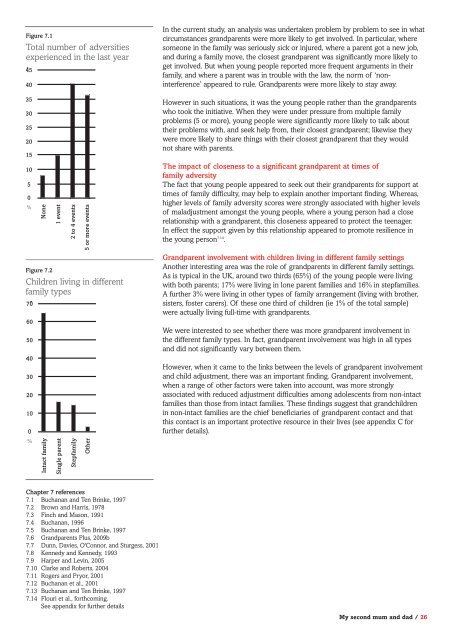“My second mum and dad” - Grandparents Plus
“My second mum and dad” - Grandparents Plus
“My second mum and dad” - Grandparents Plus
Create successful ePaper yourself
Turn your PDF publications into a flip-book with our unique Google optimized e-Paper software.
Figure 7.1<br />
Total number of adversities<br />
experienced in the last year<br />
None<br />
Figure 7.2<br />
Children living in different<br />
family types<br />
Intact family<br />
1 event<br />
Single parent<br />
2 to 4 events<br />
Stepfamily<br />
5 or more events<br />
Other<br />
Chapter 7 references<br />
7.1 Buchanan <strong>and</strong> Ten Brinke, 1997<br />
7.2 Brown <strong>and</strong> Harris, 1978<br />
7.3 Finch <strong>and</strong> Mason, 1991<br />
7.4 Buchanan, 1996<br />
7.5 Buchanan <strong>and</strong> Ten Brinke, 1997<br />
7.6 Gr<strong>and</strong>parents <strong>Plus</strong>, 2009b<br />
7.7 Dunn, Davies, O'Connor, <strong>and</strong> Sturgess, 2001<br />
7.8 Kennedy <strong>and</strong> Kennedy, 1993<br />
7.9 Harper <strong>and</strong> Levin, 2005<br />
7.10 Clarke <strong>and</strong> Roberts, 2004<br />
7.11 Rogers <strong>and</strong> Pryor, 2001<br />
7.12 Buchanan et al., 2001<br />
7.13 Buchanan <strong>and</strong> Ten Brinke, 1997<br />
7.14 Flouri et al., forthcoming.<br />
See appendix for further details<br />
In the current study, an analysis was undertaken problem by problem to see in what<br />
circumstances gr<strong>and</strong>parents were more likely to get involved. In particular, where<br />
someone in the family was seriously sick or injured, where a parent got a new job,<br />
<strong>and</strong> during a family move, the closest gr<strong>and</strong>parent was significantly more likely to<br />
get involved. But when young people reported more frequent arguments in their<br />
family, <strong>and</strong> where a parent was in trouble with the law, the norm of ‘noninterference’<br />
appeared to rule. Gr<strong>and</strong>parents were more likely to stay away.<br />
However in such situations, it was the young people rather than the gr<strong>and</strong>parents<br />
who took the initiative. When they were under pressure from multiple family<br />
problems (5 or more), young people were significantly more likely to talk about<br />
their problems with, <strong>and</strong> seek help from, their closest gr<strong>and</strong>parent; likewise they<br />
were more likely to share things with their closest gr<strong>and</strong>parent that they would<br />
not share with parents.<br />
The impact of closeness to a significant gr<strong>and</strong>parent at times of<br />
family adversity<br />
The fact that young people appeared to seek out their gr<strong>and</strong>parents for support at<br />
times of family difficulty, may help to explain another important finding. Whereas,<br />
higher levels of family adversity scores were strongly associated with higher levels<br />
of maladjustment amongst the young people, where a young person had a close<br />
relationship with a gr<strong>and</strong>parent, this closeness appeared to protect the teenager.<br />
In effect the support given by this relationship appeared to promote resilience in<br />
the young person 7.14 .<br />
Gr<strong>and</strong>parent involvement with children living in different family settings<br />
Another interesting area was the role of gr<strong>and</strong>parents in different family settings.<br />
As is typical in the UK, around two thirds (65%) of the young people were living<br />
with both parents; 17% were living in lone parent families <strong>and</strong> 16% in stepfamilies.<br />
A further 3% were living in other types of family arrangement (living with brother,<br />
sisters, foster carers). Of these one third of children (ie 1% of the total sample)<br />
were actually living full-time with gr<strong>and</strong>parents.<br />
We were interested to see whether there was more gr<strong>and</strong>parent involvement in<br />
the different family types. In fact, gr<strong>and</strong>parent involvement was high in all types<br />
<strong>and</strong> did not significantly vary between them.<br />
However, when it came to the links between the levels of gr<strong>and</strong>parent involvement<br />
<strong>and</strong> child adjustment, there was an important finding. Gr<strong>and</strong>parent involvement,<br />
when a range of other factors were taken into account, was more strongly<br />
associated with reduced adjustment difficulties among adolescents from non-intact<br />
families than those from intact families. These findings suggest that gr<strong>and</strong>children<br />
in non-intact families are the chief beneficiaries of gr<strong>and</strong>parent contact <strong>and</strong> that<br />
this contact is an important protective resource in their lives (see appendix C for<br />
further details).<br />
My <strong>second</strong> <strong>mum</strong> <strong>and</strong> dad / 26


